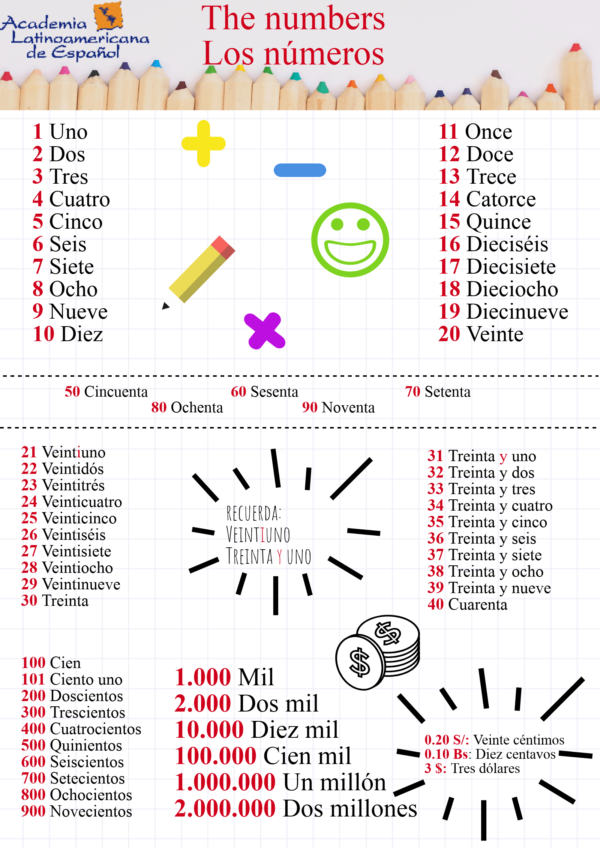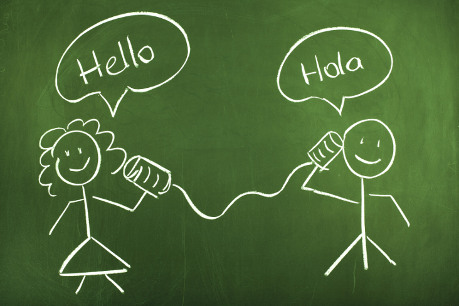Menu
The numbers in Spanish
Spanish lesson 4. The numbers
Hello there! In the previous Spanish lessons, we learned how to describe places, how to talk about the personality of other people and how to physically describe them.
Learning how to count may be a simple task, yet we can’t forget how important it is for everyday life and activities! Also, by learning the numbers, we will be able to deal with banks and money the most appropriate way, go check out our Survival Guide: banks and money to know more about this!
Let’s start by taking a look at this infographic we have prepared for you!
Bear in mind that the number one (1) in all its ways (1,21,31,41) changes depending on the gender of the word coming after.
¿Cuántos hijos tiene? ¿Cuántos hijos tiene? Tengo dos hijos, un niño y una niña Tengo uno
Some interesting facts:
Talking about measurement units: one billion in an Anglo-Saxon country such as the USA is not the same as one billion in Spanish-speaking countries. On mainland Europe, Spanish and Portuguese-speaking countries (except Brazil), one billion is equal to one million millions. Meanwhile, in English-speaking countries and Brazil, one billion is equal to one thousand millions.
| Mainland Europe, Spanish and Portuguese-speaking countries | English-speaking countries and Brazil | |
| 1 billion | 1.000.000.000.000 (one million of millions) | 1.000.000.000 (one thousand of millions) |
Also, the measuring system used in the USA differs from the one used in almost everywhere else in the world. The system used in the USA is called the United States Customary Units whereas we use the International System of Units. What’s the difference between them?
The International System of Units was implemented in 1960 to unify all the different systems into one so every country would have the same measuring references. On the contrary, the United States Customary Units takes as reference the traditional measuring system used in the antique Rome.
Let’s take a brief look at this table:
| Measures | Units | Abbreviation |
| Mass | Kilogram | kg |
| Length | Meter | m |
| Surface | Square meter | m2 |
| Volume | Liter | l |
THE NUMBERS – LOS NÚMEROS
| 1 Uno | 11 Once |
| 2 Dos | 12 Doce |
| 3 Tres | 13 Trece |
| 4 Cuatro | 14 Catorce |
| 5 Cinco | 15 Quince |
| 6 Seis | 16 Dieciséis |
| 7 Siete | 17 Diecisiete |
| 8 Ocho | 18 Dieciocho |
| 9 Nueve | 19 Diecinueve |
| 10 Diez | 20 Veinte |
| 21 Veintiuno | 31 Treinta y uno |
| 22 Veintidós | 32 Treinta y dos |
| 23 Veintitrés | 33 Treinta y tres |
| 24 Veinticuatro | 34 Treinta y cuatro |
| 25 Veinticinco | 35 Treinta y cinco |
| 26 Veintiséis | 36 Treinta y seis |
| 27 Veintisiete | 37 Treinta y siete |
| 28 Veintiocho | 38 Treinta y ocho |
| 29 Veintinueve | 39 Treinta y nueve |
| 30 Treinta | 40 Cuarenta |
| 50 Cincuenta | 60 Sesenta |
| 70 Setenta | 80 Ochenta |
| 90 Noventa | 100 Cien |
| 101 Ciento uno | 200 Doscientos |
| 300 Trescientos | 400 Cuatrocientos |
| 500 Quinientos | 600 Seiscientos |
| 700 Setecientos | 800 Ochocientos |
| 900 Novecientos | 1.000 Mil |
| 2.000 Dos mil | 10.000 Diez mil |
| 100.000 Cien mil | 1.000.000 Un millón |
| 2.000.000 Dos millones | 1.000.000.000 Un Billón |
0.20 S/: Veinte céntimos
0.10 Bs: Diez centavos
3 $: Tres dólares

Now and after all of this let’s practice a bit of math to check how much we have learned!
Do the following exercises:
We hope you have enjoyed and learned new things with this lesson! See you in the next!
1. Answer with true or false the following questions:
2. Which number corresponds to the word below?
3. Which number corresponds to the word below?
4. Which number corresponds to the word below?
5. Which number corresponds to the word below?
6. Which number corresponds to the word below?
7. Which number corresponds to the word below?
8. Solve the following and answer with letters:
a) 2 + 2 =
b) 10 + 13 =
c) 6 + 4 =
d) 50 + 30 =
e) 58 + 43 =
f) 100 + 12 =
g) 400 + 400 =
h) 62 + 17 =
I) 500 + 498 =







